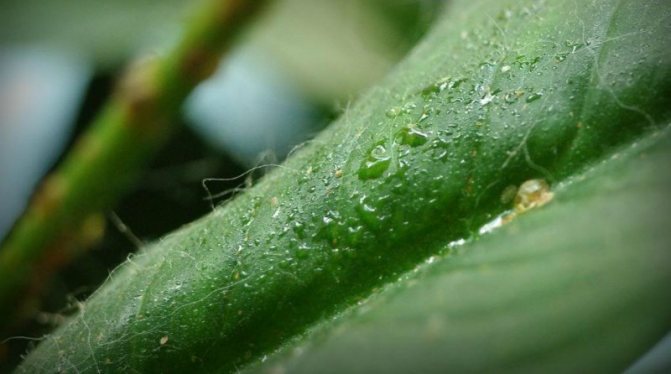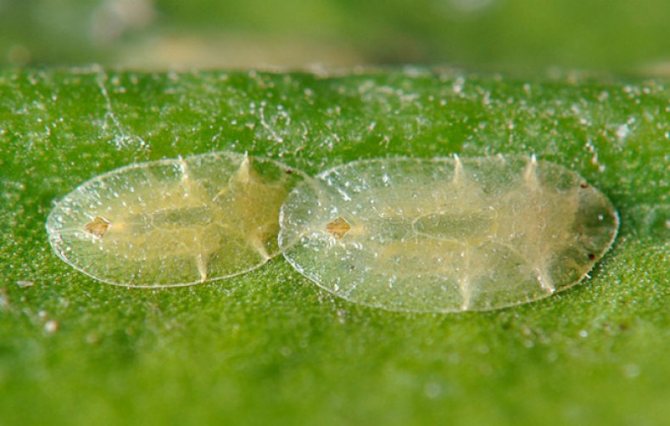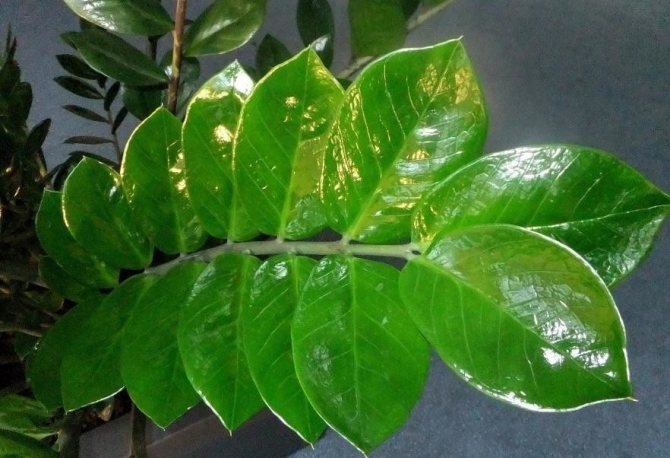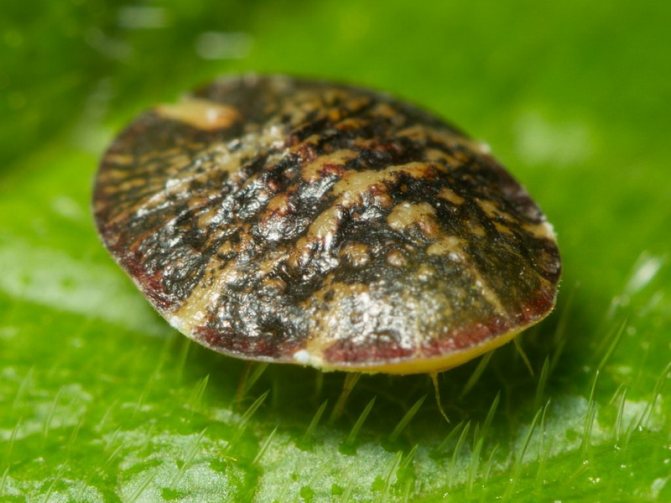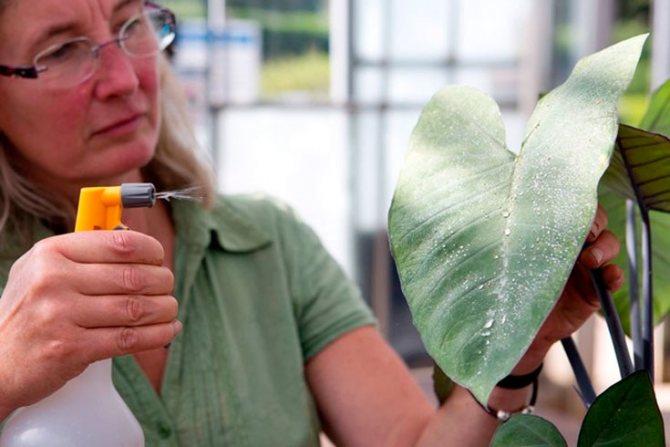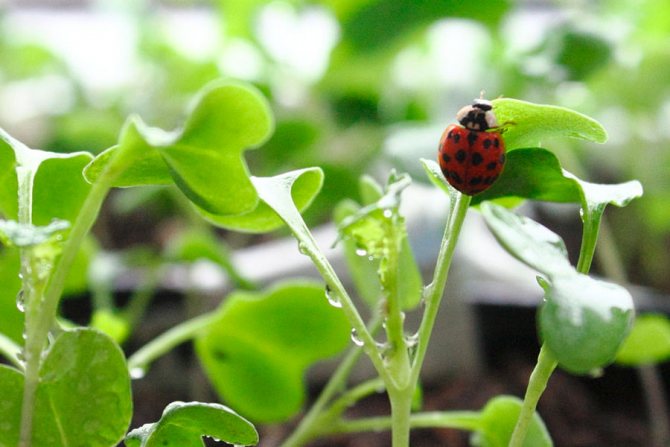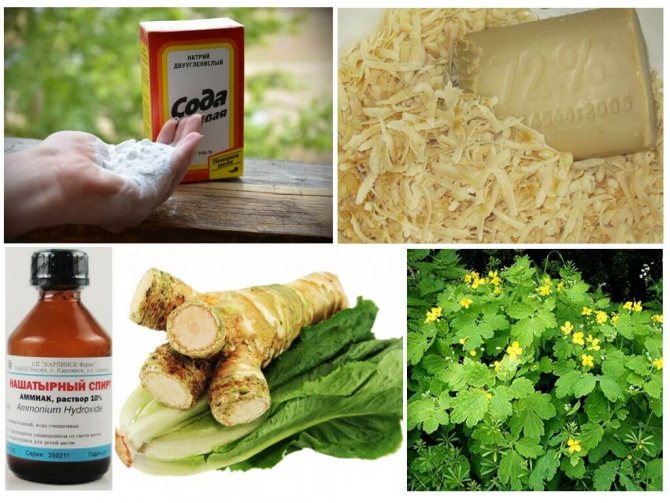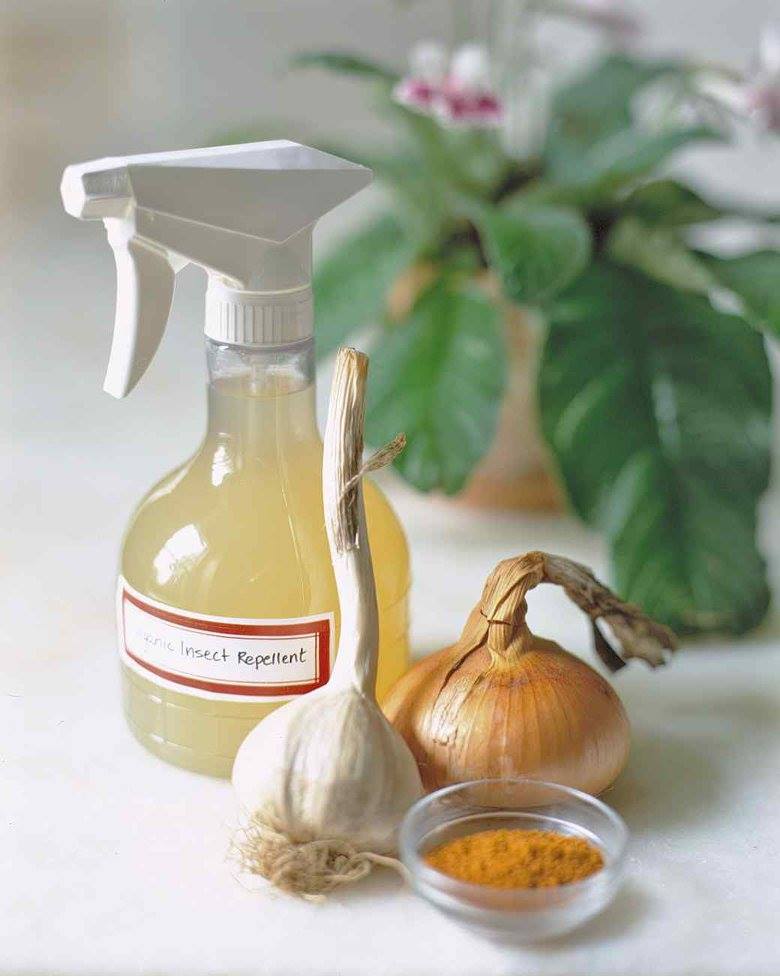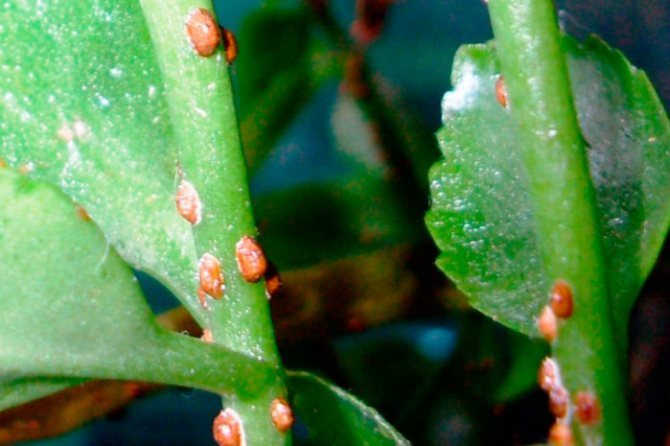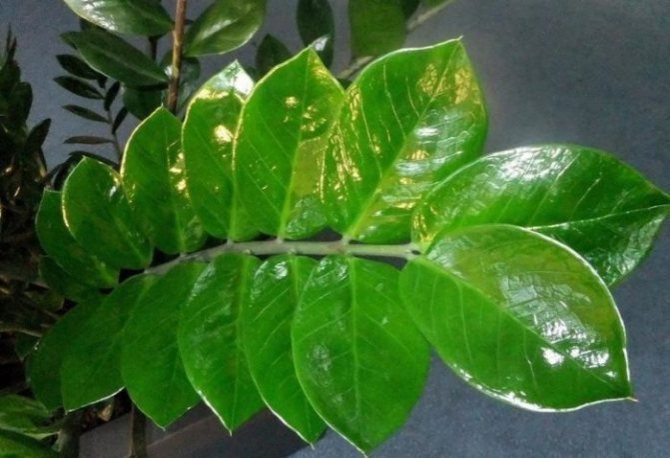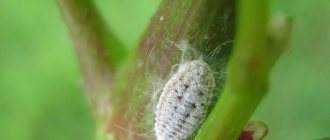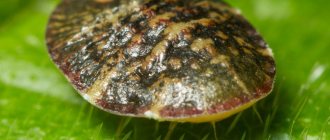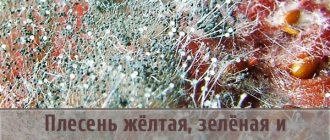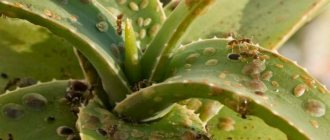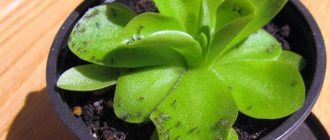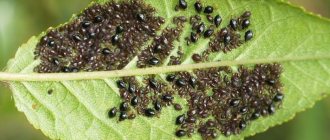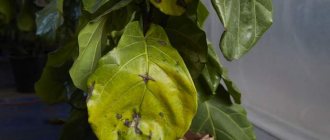Adult aphids are insects up to 2.5 mm long, translucent or light green, yellow and pink. They can be seen with the naked eye. Houseplants are usually damaged by white aphids. These insects are carriers of various viral diseases.
When infected with a pest, all parts of the plant are damaged: leaves, buds, stem tops. But aphids prefer soft and juicy shoots, from which it is easier to get food. On plants with hard leaves and milky sap, this insect rarely starts.
Why does a sticky bloom appear on plants?
The first sign of serious problems is the untidy appearance of the flower - dust and small debris stick to the leaves. The leaf plates of healthy houseplants are smooth or fluffy, but certainly not sticky. The appearance of any liquid on the tissues of the plant, except for the one that got in the process of watering, is an abnormal phenomenon that requires immediate intervention.
Sticky leaves in indoor plants, spots, drops or a layer of thick liquid on them are a signal of the appearance of insect pests in the house. They feed on plant juices and secrete substances (waste products) that leave sticky spots on the leaves. Small pests bite through the leaves, juice is released from these holes.
Since insects drink juice that contains sugar, their natural secretions are thin and sticky. They mix with the sap of the plant, covering the leaf surface with a sticky liquid.
- deterioration in flower nutrition;
- the development of a fungal, bacterial or viral infection in places of damage to the leaf plate;
- difficulty breathing and evaporation of fluid;
- violation of the processes of photosynthesis;
- slowing down the movement of moisture and nutrients from the root system to other organs, a deficiency of minerals.
But not always the appearance of sticky spots is associated with pest damage. Under natural conditions, some plants secrete a sweet liquid to attract pollinating insects, mainly orchids.
How to identify a pest
A number of pests are known that leave a sticky layer on the leaf plates. Arachnid or hemiptera insects usually settle on indoor specimens. They are well adapted to indoor life, small in size, and cannot be seen without the use of a magnifying glass.
Pest penetration routes:
- With soil for replanting. Pre-disinfect the new soil or bake it in the oven to destroy eggs and larvae.
- With acquired plants. Beginners should be moved away from existing flowers.
- With air from the street during ventilation. To avoid this, install mosquito nets on the windows.
Whatever the reasons for the appearance, whoever is the culprit for the appearance of sticky leaves on indoor flowers, it is necessary to get rid of the disease immediately.
Aphids are small insects, body length is 2-3 mm. She is dyed white or greenish and prefers indoor flowers with delicate fabrics. Often, one of the first signs of infection is the appearance of syrup-like droplets of secretory fluid.
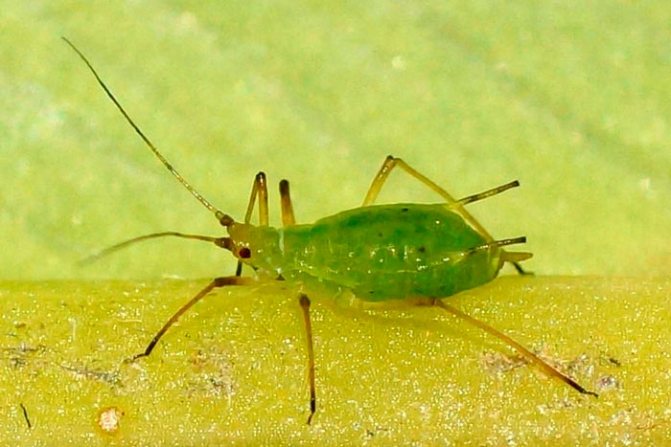
With a significant growth of the colony, the entire lower surface of the leaf plates is covered with parasites that destroy young shoots, do not allow the buds to open, and can introduce a fungus.
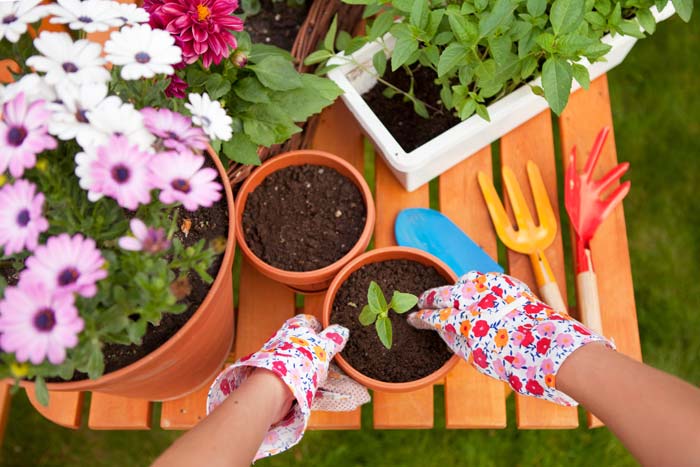

Shield
The family of hemiptera, to which the scale insect belongs, has more than 2600 species, most of which are dangerous pests that destroy garden and indoor plants. The scale is small; the length of the oval body is 2 mm. Having settled on an indoor plant, an insect in a short time can lead to its death. At the point of attachment, yellow spots appear, the leaves curl and fall off. The flower stops growing, dries up.
An important sign of the appearance of scale insects on indoor flowers is a sticky bloom. A viscous white liquid - pad, capable of completely covering the flower. The pad easily collects sooty fungus and dust on itself.
The closest relative of this pest is a false shield, they belong to the same order, they lead the same parasitic lifestyle. The false shields are larger. It is not so easy to understand whether a shield or a false shield is in front of you. It seems that the false shield has a carapace on the back, but this is a layer of the skin that has died out after molting.
The main pest of indoor flowers is a soft false shield, it is capable of destroying any plant. The size of the insect is 3-4 mm, the oval body is brown in color. The insect leaves a sticky coating not only on the leaves, but also on the window panes, near which the pot is located.
Spider mite
This small pest from the class of arachnids is almost impossible to see with the naked eye, its size is 0.2-1 mm. They feed on the cell sap of plants, their salivary glands secrete special enzymes that destroy the chloroplasts of cells... Red spider mite is able to destroy any houseplant, it loves warmth, does not tolerate excess moisture... Shiny reddish eggs can be seen on leaves or cobwebs. After the allotted time, translucent larvae emerge from the eggs, which also feed on the juices of the flower.
Signs of disease in indoor plants affected by spider mites:
- sticky leaves;
- cobweb on the crown and stems;
- scratches, cracks on the back of the leaves;
- a decrease in the intensity of color due to a violation of the processes of photosynthesis;
- dying off of plant parts;
- impossibility of tying buds, falling of existing flowers.
The spider mite is a voracious and prolific insect that can hibernate when unfavorable conditions occur. This factor makes it difficult to fight the pest.


Whitefly
Despite the white color of the body, the whitefly can be on flowers unnoticed for a long time. The pest belongs to the Homoptera family. This tiny moth does not grow more than 2 mm, its body is covered with a matte waxy coating. The female lays eggs on the inside of the leaves. The main damage to plants is caused by larvae, they damage young foliage. When there are many insects, they spread throughout the plant.
First aid and methods of control
If you find harmful insects on the plant, do the following:
- Isolate the flower from other plants to prevent infestation.
- Prepare a soapy solution, remove insects and sticky deposits from leaves and stems with a soft cloth.
- Rinse the foliage under the shower, cover the soil in the pot with foil so that the washed-off pests do not get into it.
You can fight insects with the help of folk remedies intended for spraying:
- Pour 100 g of citrus peel with 1 liter of warm water, put in a dark place for 4 days.
- 1 head of minced garlic in 1 liter of water, leave for a week. Add 50 ml of infusion to 10 liters of water.
- 1 chopped onion per 100 ml of water, leave in a closed jar for 8 days. For 10 liters of water, 20 ml of infusion is enough.
- Pour 150 g of onion husks with 10 liters of boiling water, in a day the infusion is ready.
- Grate 100 g of laundry or green soap, dissolve in 5 liters of hot water.
- 50 g of tobacco dust, 5 liters of water and a little soapy water.
If folk remedies are ineffective, you need to use insecticides. You will notice the result immediately, you will need a minimum number of repeated treatments.
- "Aktara" - systemic insecticide, used to protect indoor plants from aphids, scale insects, worms, thrips. Affects whitefly and ticks worse.
- Fitoverm actellik Is one of the most powerful common drugs.
- "Arrivo" - insecticide of contact-intestinal action, has a high initial toxicity, has a long term of protective action (up to 2 weeks).
- "Spark" - several options made on the basis of different toxic substances. The most modern drug Iskra Bio (Akarin) is an environmentally friendly product that is harmless to humans and animals.
- "Inta-vir" effective means for the destruction of adults, but not capable of destroying larvae and eggs.
- Etisso Blattlaus-Sticks - sticks that are placed in the ground. After watering, the active substance is released and spreads through the root system to all plant tissues.
- "Commander" effective both when applied to the soil and when spraying.
When processing with chemicals, follow the instructions and safety rules:
- use protective devices - gloves, respirator;
- process outdoors, on a balcony, or in a well-ventilated area;
- keep chemicals out of reach of children and animals.
Read the instructions carefully, adhere to the recommended dosages and processing times.
To avoid the appearance of pests, inspect the plants, pay special attention to the back surface of the leaves, because this is a favorite spot for insects. Observe the rules of care, do not violate the watering regime, feed indoor flowers in a timely manner. These simple measures will protect your plants from pest infestations.
Indoor plants are susceptible to numerous diseases, although they are kept in better conditions than flowers in the open field. It is very important to notice the first signs of the manifestation of diseases in time and determine the cause of their occurrence for subsequent treatment. What to do if a sticky bloom has appeared on the plants - what causes it and what are the measures to combat it.
Treatment remedies
No matter how badly the specimen is affected, you must try to save it. How to get rid of the scabbard is discussed in the following sections. The bugs are removed with folk or industrial chemicals. Then the flower is fed, the aerial part is sprayed with a growth stimulant and covered with a bag, creating an ideal microclimate.
Successful conditions for the fight against scale insects:
- Plants should be processed at a temperature of +20 ° C at least 3-4 times, otherwise the means used may be ineffective. Approximate schedule: from +20 to +24 degrees - with a frequency of 7-9 days; from +25 to +28 - with a difference of 5-7 days.
- A single use of the drug is ineffective, therefore, experts recommend a systemic method of treatment.
Causes of stickiness on home flowers
The reasons why the leaves become sticky can be as follows:
- abundant watering of flowers after the soil dries out, as a result of which excess moisture is released on the leaves;
- aphid - insects 2-3 mm long, which, although visible to the naked eye, multiply rapidly, damaging the leaves;
- mealybugs - pests that resemble aphids in appearance;
- spider mites - so small arachnids that they are noticeable only by indirect signs - the appearance of plaque and cobwebs on the leaves in places of accumulation of pests;
- caterpillars whitefly - butterflies that lay eggs on the underside of leaves, making them difficult to detect;
- scabbards - insects, named because of the structure of the body, which is covered with a tough brown shell.
The most common and difficult to eliminate reason why the leaves are covered with a sticky bloom is the damage to the plant by scabbards.
Scabbard is a dangerous insect
The scale insects are hemiptera with a very different appearance and lifestyle of males and females. If we talk about sabotage, then the flowers infect females. They can move only at a young age at the first stage of larval development, and subsequently, due to the formation of a hard shell, they remain motionless. They have no wings, and they spend their whole life on leaves, the sap of which they feed on. Male individuals do not live long and die after mating. They do not have developed nutritional organs and do not harm plants, but they can fly.
Gommoz
This disease occurs in the lower part of the trunk. Gradually rises up to the branches and down to the roots of the tree. In the lesion sites, bulges form, in which gum accumulates, which is a yellow or brown liquid that solidifies in air. The affected areas crack and die off.
Read more: Grape leaves turn yellow: what to do. The reasons
Gommosis often affects leaves and fruits. Brown spots appear on the leaves, which grow over time. On affected fruits, the skin darkens and coarsens. The pulp softens, rots and takes on an unpleasant odor.
It is quite difficult to treat this disease. Sick areas are cleaned and treated with a solution of copper sulfate. After that, the tree is removed from the soil, its roots are cleaned and transplanted into fresh soil. Diseased bark and wood are cut out, all cleanings are burned.
What is dangerous for indoor plants?
The danger of sticky plaque for indoor flowers is as follows:
- secreting juice, the plant loses nutrients and moisture;
- sticky bloom prevents the evaporation of excess moisture from the leaves and its flow along with nutrients to the aerial parts of the plant;
- the process of photosynthesis is disrupted, due to which the leaves turn yellow and fall off over time;
- sticky and sweet juice serves as a breeding ground for the development of bacteria that can harm the plant.
Therefore, the appearance of a sticky plaque is an alarming sign in which the plant must be urgently examined for the presence of pests.
Preventive measures
It is very difficult to destroy the already appeared parasites. It is much easier to prevent their appearance by observing simple preventive measures:
- Periodically inspect the green spaces carefully.
- Transplant grown flowers regularly.
- Inspect the earthen lump when transplanting. Flush the primer with hot water (approx. 55 ° C).
- Properly care for flowers according to their preferences.
- Remove dying parts of the plant in a timely manner. Dried leaves can serve as a convenient shelter for various pests.
- Before planting, scald the pots with boiling water, and steam the soil.
- Observe quarantine measures for new plants.
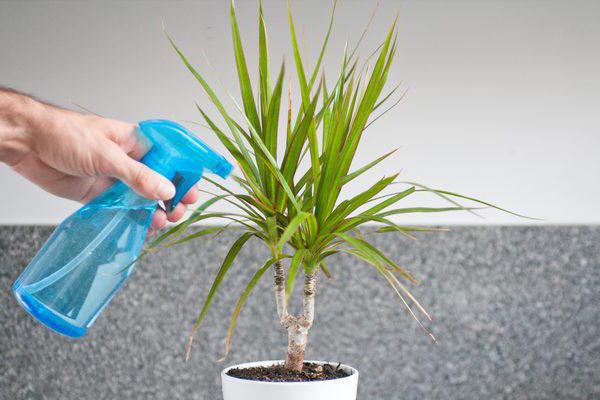

Insects are an integral part of any ecosystem, but they have no place on the green window sills of apartments. Especially if a mealybug has appeared on indoor plants. You know how to deal with a pest. Therefore, use whatever methods are available. After all, healthy indoor plants without pests are actively developing and delight the eye with bright greenery and abundant flowering.
How to deal with the disease?
To combat sticky plaque, both folk remedies and industrial preparations can be used. The first ones are used with a slight infection of the plant with parasites, they are less toxic and will not harm either plants or people. With greater caution, special preparations should be used in cases of outbreaks of pest development.
Pest control of sticky plaque
If a sticky bloom is found, the plant should be immediately isolated from neighboring healthy flowers to avoid contamination. To get rid of pests that form a white bloom on the leaves, you can use one of the following methods:
- Treat the flower with soapy water, then let it stand for a few hours and then rinse under warm water. After a few days, the treatment should be repeated.
- Pass 30 g of cloves of garlic through the garlic and pour 1 liter of warm water, add a little soap, let it brew for a day. Process the leaves with the resulting tincture several times (at intervals of 2-3 days).
- Dissolve in 1 liter of water 1 g of the universal substance Aktaraintended for the destruction of insect pests. Process the leaves of the plant, then splash a little solution under the root of the flower.
- In case of significant damage by the shield, dissolve an ampoule of Actellik in 1 liter of water... Handle the flower carefully - with gloves and outdoors. After the procedure, you should thoroughly wash your hands with soap and water.
What to do with brown scales?
Brown scales on the leaves of home flowers, left after being damaged by the scabbard, must be removed, since egg clutches may remain inside, which is fraught with a repeated outbreak of pests. This is done mechanically.
For flowers with delicate leaves, a sponge or cotton pad is suitable; for harder leaves, it is better to use a toothbrush. The disc or brush must be moistened with soapy water and each leaf of the plant must be treated, removing scales.
If the leaves turn sweet
If sweetish drops of nectar appear on the leaves of flowers, this may be an absolutely normal process. When flowering, nectar is released on the leaves of some plants. Its function is to additionally attract insects that can pollinate the flower.
As a rule, after a period of flowering, this phenomenon disappears. However, it is necessary to carefully check the flower for the presence of pests on it. If they are found, take appropriate measures.
How to get rid of the white blob?
White bloom that appears on the leaves during the life of the scale insect is very difficult to wash off. For this, a solution of the following ingredients is used:
- 10 ml of 96% alcohol;
- 15 ml of liquid soap;
- 1 liter of warm water.
All components must be mixed and then applied to the leaves by spraying or with a soft brush. After a few hours, rinse the solution under running warm water. If necessary, you can use a soft cotton pad.
Prevention is the best answer!
A heavily multiplied pest can greatly weaken or destroy the flower. Even small accumulations of parasites significantly impair the decorative properties of the plant. Fighting annoying aliens is exhausting. What should be done in order not to darken communication with our silent friends with annoying troubles?
When purchasing a new pet, carefully inspect it so that it does not have the slightest sign of pests. After a new flower appears in the house, do not immediately put it next to other plants. Just in case, let him pass the "quarantine", being far from them. If everything went well, you can place it closer to the "old-timers", creating new interesting compositions. After the diseased plant has recovered, it must be transplanted. When replanting plants, use new flowerpots for them. If you want to transplant a flower into an old favorite pot, you must first boil it with soapy water.
Periodically carefully inspect home flowers, wipe their leaves, do not allow pests to settle on them. For some plants, it is allowed to have a warm shower from time to time.
The more attentively you treat flowers, the more magnificently the living decoration of your home will grow!

